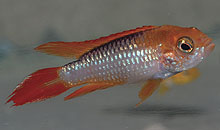WHAT'S NEW ACROSS THE WORLD
Select date in side bar to go to a What's New of previous issues
| What's New
©by Laif DeMason
This summer’s tropical fish sales seem to be better than the last two previous summers’ sales. Given the less than improved current economic conditions, some retailers put it to the extreme summer heat driving people inside more than normal. The logic goes like this: hobbyists spent more time inside looking at their set ups and shopping is always an air conditioned proposition. Indeed, those who were at the annual ACA convention in Washington DC, rarely ventured outside during the midday’s toaster oven heat! AC is way better on these extreme days. Other retailers feel that people have restricted surplus spending so much they were in need of relief. What could be better than buying a few new cichlids to lift your spirits?
Here’s “what’s new” on the cichlid scene:
|
Lake Malawi
Collectors in Malawi are still working, although not as briskly as they would hope. Wild material is still available from Tanzania, but only a few times per year according to demand. Collectors along the Malawi coast are still hammering away, but Mozambique has not been harvested lately. The many brightly colored blue and green haplochromines stir little interest for most. Maybe hobbyists prefer the intensely colored man-made fishes from the Far East.

Developed in the Far East by combining various strains of hybrid Aulonocara, this strain has the bright colors of the ‘Fire Fish’ peacock along with sparse spotting of the ‘OB’ peacock.
|

Some old favorites are still in demand and rarely collected in the lake due to the large effort needed. Here Placidochromis phenochilus, originally from Lupingu, Tanzania, remains a popular Malawi cichlid.
|
Madagascar
While certainly no new material is coming out of Madagascar, certain species have come in and out of popularity due to scarcity. Several forms are still being bred in Florida and the Far East, though demand has been relatively low over the last few years. However, new interest has found its way into the cichlid hobby, perhaps because these cichlids are becoming better known.

While several localities are known for this cichlid, all are classified as one species, Ptychochromis oligacanthus. Pictured here is the ‘standard’ form, however, there are varieties that have different shades of red in the unpaired fins as well.
|

Generally (or historically), the large spot Paratilapia, (whether P. bleekeri or P. polleni), has been the most popular due to its adorning spots. However, recently, demand has developed for the small spot variety, often called P. polleni, as this species name was used in the past to refer to this small spot type.
|
Lake Tanganyika
Collectors and exporters alike are starting to wonder whether it is still worth selling cichlids for a living. The work is difficult, expenses continue to rise, and most hobbyists are purchasing less. Maybe if there were no exported Tanganyika fishes for a couple of years, then the normal fare would be more attractive.
|
WHAT'S NEW: LAKE TANGANYIKA
|

A new but secret collecting spot near Bulu Point, Tanzania has produced a nicely colored Altolamprologus compressiceps type. This one is overall yellowish with dabs of red in its unpaired fins.
|

There is a fair demand for the featherfin types of late, although wild-caught fish rarely have any color by the time they reach importer’s tanks. Recently Cyathopharynx foae from Sibwesa (TZ) are available. Photo by A. Konings.
|

Demand for many of the Petrochromis species continues. One of the most sought after types is the species named ‘Moshi Orange’ from various places in central Tanzania.
|

Several color varieties of Neolamprologus brichardi are known from different points around the lake. This variety was collected in southern Congo south of Kapampa.
|
Neotropics
Popularity of South and Central American cichlids continues to increase. In fact, the majority of articles written for this magazine continue to come from dedicated hobbyists from the ‘neotropical’ persuasion. I can’t say that I blame them! The variety from this part of the world continues to amaze us from the dwarf Apistogramma to the monster pike cichlids and all the forms in between.

Originally called the Honduran Red Point ‘convict’, a new species name has been applied to these convict types: Amatitlantia siquia. This colorful little cichlid pictured here, is a female from a strain hailing from Lake Nicaragua.
|

Bred in Eastern Europe, a form of red Apistogramma agassizi sports intensive flaming red hues. It is very impressive indeed and often sold as ‘Fire Red’ agassizi, although I must admit that the strain varies somewhat depending on who you buy them from.
|
Select date in side bar to go a What's New of previous issues
|









